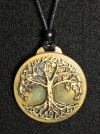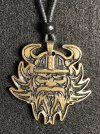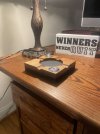I have been making small brass medallions for a while now, on the CNC machine, for use as pendants (see attached photo.) I have never tried inlay of any kind (probably be more sensible to try wood on wood first, but, well, sometimes compulsive behavior gets in the way of common sense.) Anyway, I was thinking about making a jewel box or something with walnut or paduk, with inlays of brass medallions - like the necklace medallion, but without the cord.
Anybody had any experience, good or bad, inlaying metal into wood? Anything special to watch out for?
Thanks.
Anybody had any experience, good or bad, inlaying metal into wood? Anything special to watch out for?
Thanks.



